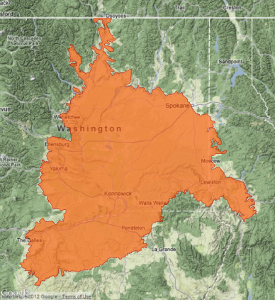Columbia Plateau Ecoregion
 The Columbia Plateau landscape (about 70,000 km2 in Washington) is mostly privately owned, along with some large reservations (e.g. Yakama Nation, Confederated Tribes of the Colville Reservation), wildlife refuges, and TNC preserves. Much of the native shrub-steppe and grassland habitat in the area has been converted to agriculture, and much of the remaining habitat is heavily impacted by over-grazing, non-native grasses, and changes in fire frequency. A number of wildlife species associated with, or dependent on, sagebrush are found in this landscape and have suffered population declines (sharp-tailed and sage grouse, sage and Brewer’s sparrows, Washington ground squirrel) and may persist only in relatively isolated populations.
The Columbia Plateau landscape (about 70,000 km2 in Washington) is mostly privately owned, along with some large reservations (e.g. Yakama Nation, Confederated Tribes of the Colville Reservation), wildlife refuges, and TNC preserves. Much of the native shrub-steppe and grassland habitat in the area has been converted to agriculture, and much of the remaining habitat is heavily impacted by over-grazing, non-native grasses, and changes in fire frequency. A number of wildlife species associated with, or dependent on, sagebrush are found in this landscape and have suffered population declines (sharp-tailed and sage grouse, sage and Brewer’s sparrows, Washington ground squirrel) and may persist only in relatively isolated populations.
Partners in the Arid Lands Initiative have participated in a series of Conservation Action Planning (CAP) workshops to identify biological targets, environmental stressors (including climate change), and strategies and measures for conservation and management. Providing Vulnerability Assessment products to the participants will help make climate adaptation an explicit part of the CAP effort.
Partners: Arid Lands Initiative
